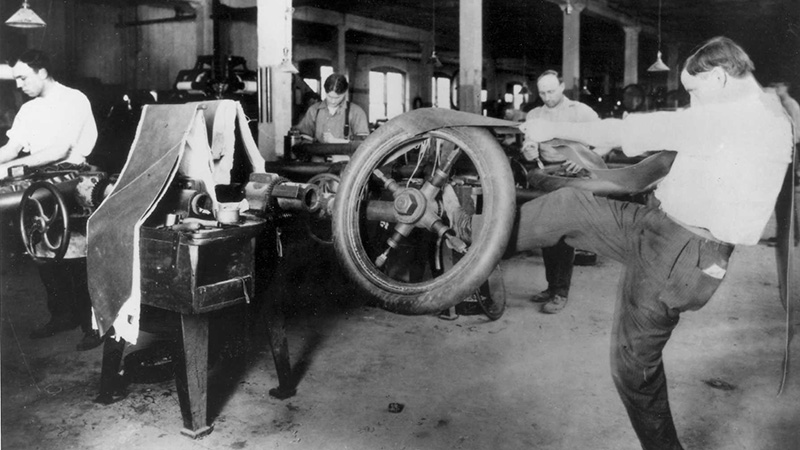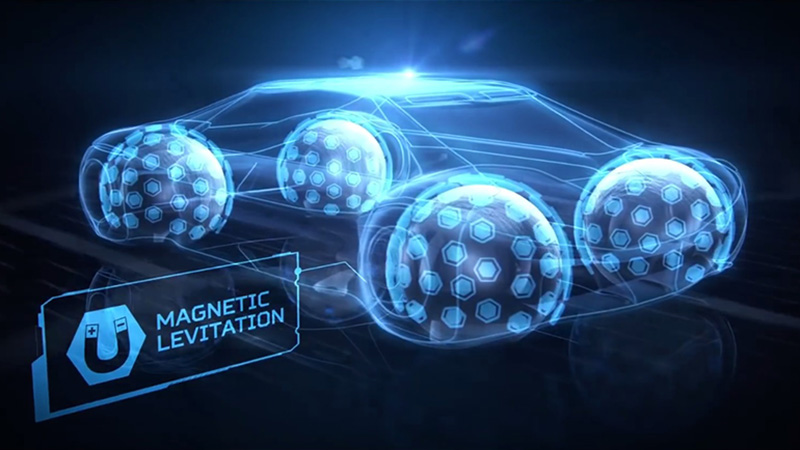It has been over 10,000 years since the invention of the wheel. Originally just a solid, spinning disc made of wood mounted on an axle, there have been developments in the long history of this technology that revolutionized human civilization forever.
First came the spoked wheels, making the invention lighter and the vehicles swifter. Then towards the end of the 1800s, wheels shod with rubber tires were introduced to the world and quickly became the norm for all road-going vehicles.
In recent years, there have been many innovations in this field from lightweight alloy wheels, run-flats, and low-rolling-resistance tires, to Goodyear's BH03 tire concept that produces electricity from the heat created by rolling, and even tires made from soybeans. However, these are innovations to an already great idea and the basic shape and model of the wheel hasn't changed much.

Fast forward to this year's Geneva Motor Show where Goodyear had its new tire concept, named, quite aptly, the Eagle-360. A spherical, futuristic design for the future of automobiles seems congruent as the tire manufacturer claims that the Eagle-360 will be fitted to upcoming autonomous cars. The spherical design complemented by magnetic levitation means that the autonomous car will be able to pull off parallel parking maneuvers with ease. Besides being designed to offer 360-degree mobility, save on tire wear, and have customized 3D-printed tread capable of stiffening in dry conditions and softening in the wet, the tire comes with an array of sensors that works in conjunction with the autonomous car.
The sensors embedded in the Eagle-360 increase safety by communicating road and weather conditions, such as black ice, standing water, or sudden obstacles, to the vehicle control system and other nearby cars. The now standard pressure monitoring system will feature in addition to tread monitoring. The tire can also rotate itself to regulate tread wear and ensure longer usage of the tire. Goodyear calls all this software IntelliGrip.

Taking a cue from nature, the tread will be made of a synthesized material that behaves in the same manner as a sponge, stiffer in the dry and softer when water is involved. This should make adapting to aquaplaning and sudden change of conditions quite easy, significantly improving safety and driving performance.
Here's two reasons why Goodyear's concept tire effectively is a reinvention of the wheel, and not just an innovation. First, it looks quite a bit different. The Eagle-360 is a sphere with a curved contact patch, while nearly every wheel made since the dawn of time has been circular with a flat contact patch. The second is that the mounting for Goodyear's tire is also different. What started out as a simple axle attached to wheels first developed into simple suspended axles with springs, and then morphed into adaptable springs and dampers on individual wheels. However, these concept tires will essentially be kept in place solely by magnets. That means there won't be tens of small moving, and very breakable, parts which also indicates that there will be a lower net loss of transmission. The lack of springs also points to a lack of an axle, something that most modern cars with independent suspensions do possess.
Until we can develop the technology to make the hovering DeLorean from Back to the Future a reality, we will continue to need tires and Goodyear's concept does showcase a very viable reinvention of an already good idea. The company expects about 85 million autonomous cars sold annually and hopes to tire a large number of them with Eagle-360s. I believe it is only a matter of time before one of the car manufacturers currently in the running to bring autonomous cars to full-scale production will announce a partnership to further develop the concept.
First came the spoked wheels, making the invention lighter and the vehicles swifter. Then towards the end of the 1800s, wheels shod with rubber tires were introduced to the world and quickly became the norm for all road-going vehicles.
In recent years, there have been many innovations in this field from lightweight alloy wheels, run-flats, and low-rolling-resistance tires, to Goodyear's BH03 tire concept that produces electricity from the heat created by rolling, and even tires made from soybeans. However, these are innovations to an already great idea and the basic shape and model of the wheel hasn't changed much.

Fast forward to this year's Geneva Motor Show where Goodyear had its new tire concept, named, quite aptly, the Eagle-360. A spherical, futuristic design for the future of automobiles seems congruent as the tire manufacturer claims that the Eagle-360 will be fitted to upcoming autonomous cars. The spherical design complemented by magnetic levitation means that the autonomous car will be able to pull off parallel parking maneuvers with ease. Besides being designed to offer 360-degree mobility, save on tire wear, and have customized 3D-printed tread capable of stiffening in dry conditions and softening in the wet, the tire comes with an array of sensors that works in conjunction with the autonomous car.
The sensors embedded in the Eagle-360 increase safety by communicating road and weather conditions, such as black ice, standing water, or sudden obstacles, to the vehicle control system and other nearby cars. The now standard pressure monitoring system will feature in addition to tread monitoring. The tire can also rotate itself to regulate tread wear and ensure longer usage of the tire. Goodyear calls all this software IntelliGrip.

Taking a cue from nature, the tread will be made of a synthesized material that behaves in the same manner as a sponge, stiffer in the dry and softer when water is involved. This should make adapting to aquaplaning and sudden change of conditions quite easy, significantly improving safety and driving performance.
Here's two reasons why Goodyear's concept tire effectively is a reinvention of the wheel, and not just an innovation. First, it looks quite a bit different. The Eagle-360 is a sphere with a curved contact patch, while nearly every wheel made since the dawn of time has been circular with a flat contact patch. The second is that the mounting for Goodyear's tire is also different. What started out as a simple axle attached to wheels first developed into simple suspended axles with springs, and then morphed into adaptable springs and dampers on individual wheels. However, these concept tires will essentially be kept in place solely by magnets. That means there won't be tens of small moving, and very breakable, parts which also indicates that there will be a lower net loss of transmission. The lack of springs also points to a lack of an axle, something that most modern cars with independent suspensions do possess.
Until we can develop the technology to make the hovering DeLorean from Back to the Future a reality, we will continue to need tires and Goodyear's concept does showcase a very viable reinvention of an already good idea. The company expects about 85 million autonomous cars sold annually and hopes to tire a large number of them with Eagle-360s. I believe it is only a matter of time before one of the car manufacturers currently in the running to bring autonomous cars to full-scale production will announce a partnership to further develop the concept.


Sign in to post
Please sign in to leave a comment.
Continue